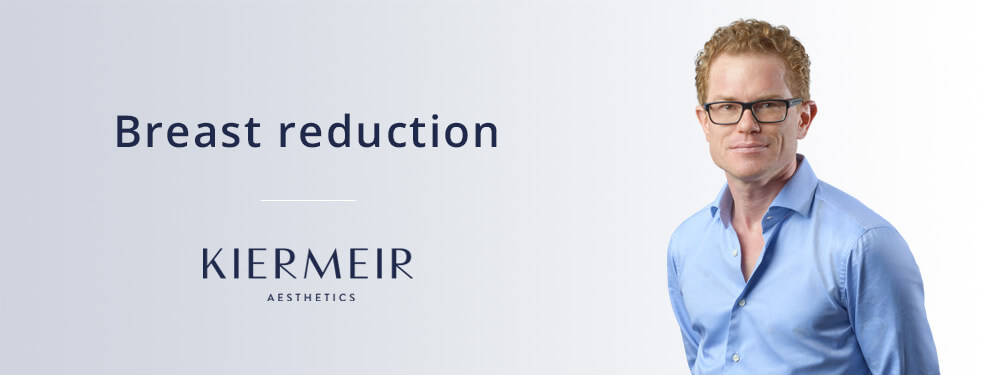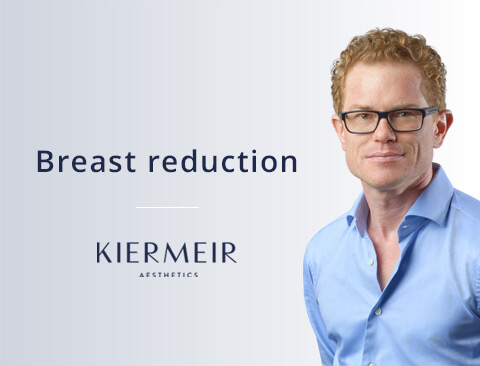Breast reduction in Bern

Dr. med. David Kiermeir
Specialist for plastic, reconstructive and aesthetic surgery (FMH)
more than 15 years of surgical experience
since 12 years exclusively active in the field of plastic and aesthetic surgery
over 6,000 performed surgeries
Facts on breast reduction
| Treatment duration: | approx. 2 - 3 hours |
| Anaesthesia: | general anaesthetic |
| Hospital stay: | 1 - 2 days |
| Removal of sutures: | not necessary |
| Sports: | after approx. 6 weeks |
| Costs: | CHF 13.000 |
When is breast reduction advisable?
If a woman’s bust is too large, it can not only lead to pain in her shoulders and neck but also cause severe discomfort in the thoracic spine region. Furthermore, oversized breasts are a common trigger of psychological and social problems – though the condition can be effectively combated through breast reduction surgery.
In a procedure to reduce the size of a woman’s breasts, glandular tissue is removed, the nipples are shifted upwards and a new breast shape is created in a 2–3 hour operation performed under general anaesthetic.
In addition to classic techniques with inverted T-shaped incisions, we also practice modern methods which result in a single straight scar.
The ultimate results of such operations become apparent after 6 to 12 months and last for at least 10 years. In the vast majority of cases, though, the transformation is permanent. Nevertheless, the natural ageing process can result in further changes to the breast.
Frequently asked questions on breast reduction
Breast reduction treatment usually requires a 1–2 day stay with us here in Bern, which should be followed by 2 weeks off work. You should also avoid any sports or physically strenuous activities for 4 weeks after treatment. The bandages are changed for the first time after 1–2 days, at which point any surgical drains are also removed.
As we use absorbable sutures in this procedure, there’s no need to remove them. Patients have to wear a sports bra for around a month after the surgery, while scars are treated with scar cream and need to be protected against UV radiation for at least 6 months using sun screen.
What’s more, after breast reduction surgery you should take special care to maintain your weight and avoid gaining or losing weight, as there is a risk that the aesthetic results may otherwise be impacted. If you slim down considerably following a breast reduction, losing more than 5kg in doing so, the breast skin may slacken – impacting on the aesthetic created by your surgeon.
The very minor risks, which vary depending on a person’s situation, include the formation of bumpy, beaded scars and sensory disturbances around the nipple. However, such symptoms can usually be remedied. Other possible side effects include secondary haemorrhages, infections and wound healing deficits.
At the very start of your course of treatment, we’ll arrange a detailed consultation meeting in which the doctor can explain the necessary preparation and aftercare measures to you. As with all procedures involving general anaesthesia, it’s advisable to avoid alcohol and nicotine for up to two weeks prior to the operation. If you regularly take medication, this is something you must discuss with the doctor in advance.
The weight of the individual patient also plays a key role – it’s important that they’re of normal weight, as oversized breasts in overweight patients can usually be remedied without surgery. When women lose weight, the volume of their breasts often reduces disproportionately.
You should expect to lose your ability to breastfeed following breast reduction surgery. However, there are certain techniques which will preserve both tactile sensation in the area and the connection of glandular tissue to the nipple in full, or at least to a large extent. As a result, there are also many women who can breastfeed even after a breast reduction.
In Switzerland, health insurance providers generally cover the cost of breast reduction surgery if there is a medical reason to do so. For this to be the case, the oversized breasts would have to cause the patient severe discomfort (such as shoulder and back pain) which cannot be treated by physiotherapy. Other medical justifications could be rashes or open sores in the crease below the breast that can’t be remedied with hygienic measures. For a health insurance provider to bear the costs of such an operation, at least 500g of glandular tissue has to be removed from each breast. A further precondition is that the patient is of normal weight, as overweight patients are initially advised to diet; eligible patients usually have a body mass index of under 25.
You should expect your breasts to grow larger again if you gain a considerable amount of weight. Breasts are made up of glandular tissue and have a relatively high fat content. However, how much a woman’s breast will grow varies from one person to the next. Nevertheless, it is advisable to keep your weight as stable as possible after the operation, as significant weight changes can also cause scars to stretch and become enlarged.
Breast reduction can be combined very effectively with other treatments. Reducing the size of a woman’s bust also entails lifting the breasts, as the smaller breasts created in the surgery usually hang down somewhat. The technique used in breast reduction surgery is very similar to the one used in a breast lift. Breast reduction surgery can also be easily combined with other procedures, such as liposuction, if the patient wishes to do so.
A breast reduction is not a particularly painful procedure, at least when compared with surgery to augment breasts. While common painkillers are sufficient to remedy any minor pain for the first week after the procedure, very few patients need any pain medication beyond this date.
That depends on the technique used. The so-called ‘anchor scar’ is created when tissues are removed in a keyhole configuration. In this case, the nipple is generally in the lower part of the breast and is shifted upwards during the course of the operation. This step creates a vertical scar. A horizontal scar is created when the lower part of the breast is sutured back together.
Here in our clinic in Bern, we always perform breast reduction surgery under general anaesthetic. The operation lasts between 2.5–3 hours and, depending on the patient’s constitution and the amount of tissue to be removed, may be carried out as an inpatient or outpatient procedure. After the operation, the patient has to wear a sports bra for 4 weeks and should avoid sporting activities for 2–4 weeks.
A variety of surgical techniques are used in breast reduction procedures, depending on the manner in which the glandular structure is to be changed. The scar, which will be visible later, is always the same – and is usually described as being anchor-shaped. This means that the surgery will always create a scar around the areola in addition to vertical and horizontal scars. However, there are various techniques to lift the areola and ensure blood flow. This blood flow will either be supplied from above, below, centrally or from within. In his Bern practice, Dr Kiermeir primarily uses techniques that supply the blood flow from above or below. However, the issue of which technique is best suited depends on the specific situation. In severe cases when the nipple has to be lifted further, it’s better for the blood flow to come from below, as this provides additional security and stability.
The most common reason given by patients for breast reduction surgery is that they suffer from shoulder, back and neck pain. In most cases, strengthening the back muscles and physiotherapy fail to solve the issue. A large bust – which, instead of being in the correct location, may now be far too low – is much worse for a woman’s body because of how it impacts on her biomechanics. It can result in postural changes and defects, and can mean that muscles no longer work as they should. A further reason for breast reduction is skin problems in the crease below the breast. In summer, for instance, a time when people perspire quite heavily, some women suffer from redness, open sores and even fungal infections. Psychological factors are another possible motivation: many women simply aren’t comfortable in their own skin and feel as though they’re being judged and seen as little more than a pair of breasts. What’s more, oversized breasts are often very impractical, particularly if the woman in question is very active.
CONTACT
Opening hours
| Monday | 8.00 a.m. - 5.00 p.m. |
| Tuesday | 8.00 a.m. - 5.00 p.m. |
| Wednesday | 8.00 a.m. - 5.00 p.m. |
| Thursday | 8.00 a.m. - 5.00 p.m. |
| Friday | 8.00 a.m. - 4.00 p.m. |
and by appointment



